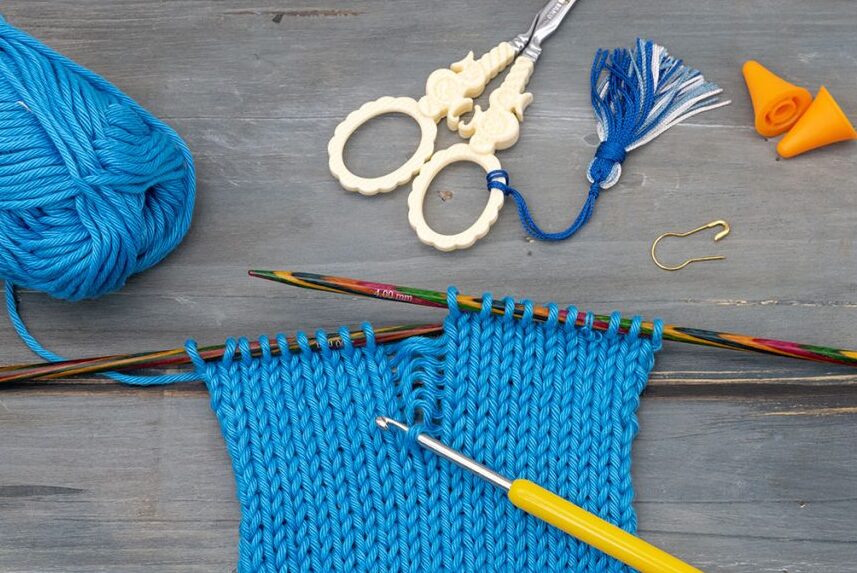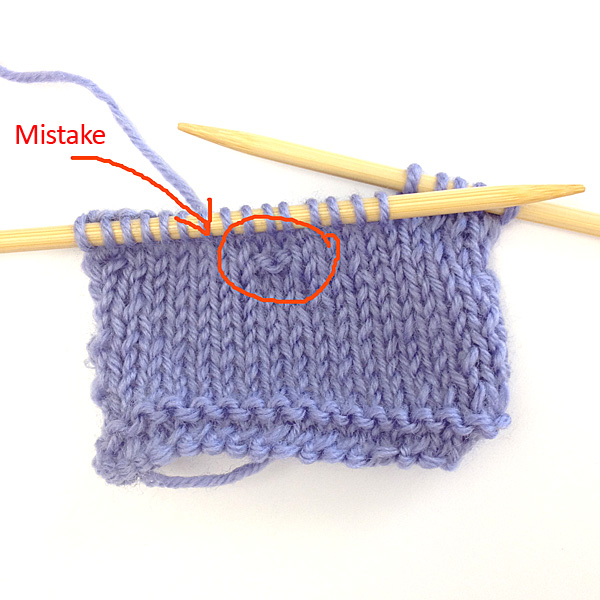Introduction
Knitting is a relaxing and creative craft, but even the most experienced knitters encounter mistakes. Whether you’re new to knitting or a seasoned pro, knowing how to fix common knitting mistakes can save your projects and boost your confidence. In this guide, we’ll explore various knitting mistakes, how to identify them, and step-by-step solutions to correct them. From dropped stitches to incorrect gauge, you’ll learn practical tips and techniques to perfect your knitting skills.

10 common knitting mistakes…
1. Dropped Stitches
Identifying the Problem
Dropped stitches occur when a loop of yarn falls off the needle, potentially unraveling part of your work. This mistake is usually visible as a column of loose, unstructured stitches.
Step-by-Step Solution
- Stop and Assess: Don’t panic. Identify how far down the dropped stitch goes.
- Use a Crochet Hook: Insert a crochet hook into the dropped stitch, picking up the loop.
- Work Upward: Gently pull the yarn through, working the stitch back up to the needle.
- Re-knit: If the dropped stitch affects several rows, use a knitting needle to rework the rows, ensuring that the stitch pattern is restored.
Preventative Tips
- Regularly check your work.
- Use stitch markers to help keep track of your stitches.
2. Incorrect Gauge
Identifying the Problem
Gauge issues arise when your knitting doesn’t match the pattern’s specifications, which can affect the size and fit of your project.
Step-by-Step Solution
- Check Your Gauge: Knit a swatch and measure your stitches per inch.
- Adjust Needle Size: If your gauge is off, try using a different needle size. Larger needles create looser stitches, while smaller needles create tighter stitches.
- Re-knit the Swatch: Knit a new swatch with the adjusted needle size to confirm the correct gauge.
Preventative Tips
- Always knit a gauge swatch before starting a project.
- Consider different yarns and needle sizes if your gauge is consistently off.
3. Misaligned Pattern
Identifying the Problem
A misaligned pattern happens when the stitches don’t match up with the design, such as cables or colorwork that doesn’t line up.
Step-by-Step Solution
- Locate the Error: Identify where the pattern started to go wrong.
- Frog Back (Rip Back): Carefully unravel the portion of the work with the error.
- Re-knit Correctly: Follow the pattern instructions closely as you re-knit the rows.
Preventative Tips
- Keep a close eye on pattern instructions.
- Use a row counter to track your progress.
4. Tension Issues
Identifying the Problem
Tension issues lead to uneven stitches or a project that’s too tight or too loose. This is often noticeable as irregular stitch sizes.
Step-by-Step Solution
- Identify Tension Variations: Look for areas where the stitches are inconsistent.
- Adjust Your Knitting Style: Experiment with your grip on the yarn and needles.
- Re-knit Problem Areas: For significant tension issues, you may need to rip back and re-knit those sections with adjusted tension.
Preventative Tips
- Practice maintaining a consistent tension.
- Try different yarns or needle types if you consistently have tension issues.
5. Yarn Pooling
Identifying the Problem
Yarn pooling occurs when variegated yarn creates unwanted patterns or color patches in your project.
Step-by-Step Solution
- Change Yarn Direction: Rotate the yarn or change the starting point of the yarn to alter the pooling.
- Switch Yarn: Use a different color or brand of yarn if the pooling is severe.
- Re-knit Sections: Adjust the pattern or stitch count to balance the colors.
Preventative Tips
- Consider using solid or semi-solid yarns for more uniform color patterns.
- Practice knitting with different yarns to see how they pool.
6. Mistakes in Lace Patterns
Identifying the Problem
Lace patterns can be complex, and mistakes often result in missed or extra yarn overs or decreases.
Step-by-Step Solution
- Identify Mistakes: Use a lifeline (a piece of contrasting yarn) to mark rows and easily spot where the error occurred.
- Unravel Back: Carefully frog back to the last correct row.
- Re-knit the Pattern: Follow the lace pattern instructions closely as you re-knit.
Preventative Tips
- Use lifelines in lace projects.
- Read lace pattern charts carefully.
7. Mistakes in Colorwork
Identifying the Problem
Colorwork mistakes, such as incorrect color placement or stranded yarns showing through, can disrupt the pattern.
Step-by-Step Solution
- Locate the Error: Identify where the colorwork pattern deviates from the chart.
- Fix Mistakes: Use a crochet hook or tapestry needle to correct colorwork mistakes.
- Re-knit Sections: If needed, frog back and re-knit sections with corrected color placement.
Preventative Tips
- Follow color charts closely.
- Practice colorwork techniques to improve accuracy.
8. Uneven Edges
Identifying the Problem
Uneven edges can result from irregular increases or decreases or from not maintaining the edge stitches correctly.
Step-by-Step Solution
- Assess the Edges: Determine if the edges are uneven due to increases or decreases.
- Adjust Technique: Use consistent edge stitches and maintain a regular increase/decrease pattern.
- Re-knit Edges: If necessary, frog back to the problematic edge and re-knit using a more controlled technique.
Preventative Tips
- Use edge stitch patterns to create a neater edge.
- Practice maintaining consistent increases and decreases.
9. Missing or Extra Stitches
Identifying the Problem
Missing or extra stitches can disrupt the pattern and affect the overall shape of your project.
Step-by-Step Solution
- Count Stitches: Regularly count your stitches to catch errors early.
- Identify the Issue: Determine if you’re missing or have extra stitches.
- Fix the Mistake: Use a crochet hook or needle to add or remove stitches as needed.
Preventative Tips
- Keep a close watch on your stitch count.
- Use stitch markers to keep track of key points.
10. Project Shape Issues
Identifying the Problem
Shape issues occur when the project doesn’t match the intended dimensions or shape, such as a sweater that’s too large or a blanket that’s too small.
Step-by-Step Solution
- Measure Regularly: Check the dimensions of your project against the pattern specifications.
- Adjust as Needed: If the shape is off, adjust your knitting technique or yarn choice.
- Re-knit Sections: Frog and re-knit problematic areas if necessary.
Preventative Tips
- Follow pattern instructions carefully.
- Measure your project frequently during knitting.
Conclusion
Conclusion: Mastering the Art of Fixing Common Knitting Mistakes
Knitting is an art that requires patience, skill, and attention to detail. While mistakes are an inevitable part of the learning process, knowing how to fix them can make all the difference between a beautiful, professional-looking project and a frustrating, abandoned one. By understanding the common knitting mistakes outlined in this guide, you’ll be better equipped to identify and correct errors, ensuring your projects turn out flawless and fabulous.
Remember, fixing mistakes is not a failure, but an opportunity to learn and improve. With practice and experience, you’ll develop the skills and confidence to tackle even the most complex projects. So, don’t be afraid to make mistakes – instead, embrace them as a chance to refine your craft and become a master knitter.
Key Takeaways:
- Consistency is key: Regularly check your tension, stitch count, and pattern to avoid mistakes.
- Frogging is your friend: Don’t hesitate to rip out your work to fix mistakes – it’s a crucial step in ensuring a perfect finish.
- Practice makes perfect: The more you knit, the more familiar you’ll become with common mistakes and how to fix them.
- Stay calm and patient: Fixing mistakes can be frustrating, but taking a deep breath and working methodically will help you resolve issues efficiently.
By following these tips and mastering the art of fixing common knitting mistakes, you’ll unlock a world of creative possibilities and enjoy the rewarding experience of knitting with confidence and precision. Happy knitting!
Knitting Mistakes Are The Part Of Process……
READ MORE
Crochet Tip: 5 Proven Strategies to Design Unique Patterns and Projects
Business Startup Guide: 4 Steps to Launch Knitting or Crochet Enterprise





Pingback: Crochet Headbands : 10 Amazing Patterns..